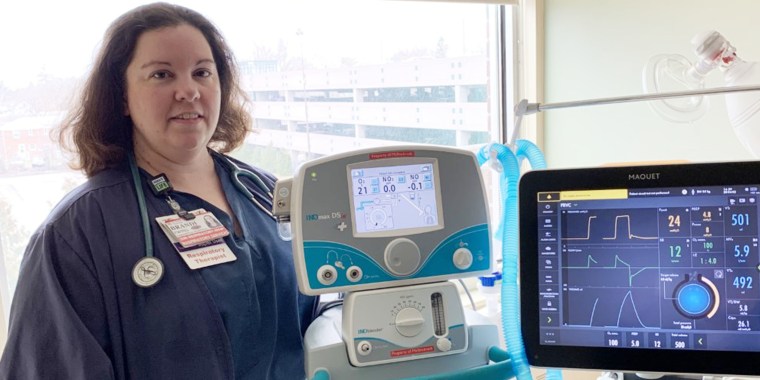Ventilators can mean the difference between life and death for severely ill COVID-19 patients. If you need a breathing machine, you’ll need a respiratory therapist to keep it running properly, determine the appropriate settings, provide constant monitoring and make any changes as your condition improves or worsens.
Brandi Ewing, 40, is the director of respiratory services at St. Peter’s Health Partners in Albany, New York. She shared what it’s like to be a respiratory therapist in an interview with TODAY.

Six months ago, nobody knew who the heck we were. Now everybody is clamoring to find out what we do. A lot of people are suddenly recognizing our work, but at the same time, it’s very stressful because everybody is truly depending on us.
Even before the coronavirus outbreak, there’s been both a state-wide and a national shortage of respiratory therapists. In order to become one, you need a two- or a four-year degree specializing in airway management, including management of the ventilators. It’s not just putting a machine on — there’s a lot of art and science that goes into it.
The process to put a patient on a ventilator begins with making the right decisions. Does the patient really need a ventilator, or are there some other options that we can do to prevent that? Because once they do go on the ventilator, there are risk factors that go into effect that could significantly impact their overall condition and outcome.
If we do put them on the ventilator, there’s a process called intubation to insert a tube into their airway. It’s definitely not a pleasant experience so patients in an acute care ICU setting typically will be on a lot of sedation. Plus, whatever is going on with their health puts an extra strain on their heart and lungs, and sometimes the better thing is to let their body rest.
On the ventilator, we then set a certain rate — how fast the person breathes. We set a volume — how big of a breath a person takes in. We also set the percentage of oxygen and the pressure that’s put into the lungs — that pressure also helps with the oxygenation.
There’s a lot of monitoring that needs to happen to make sure that the patient is safe and those settings are appropriate.
The problem with the coronavirus is that patients are getting a condition called ARDS — acute respiratory distress syndrome. It makes your lungs very stiff so it makes it very hard to breathe in and out, and also very hard for the oxygen to get into your blood. That can cause other organs to fail and it can significantly impact a person’s survivability.
The ventilator takes a lot — or all — of the work off the patient.
You need to make sure there’s enough pressure to get the oxygen into the bloodstream, but not so much that it damages the lungs. Too much pressure can also compress your heart and make it so it's not able to function as effectively as it ought to.
You’re monitoring the patient’s oxygenation and vital signs, and you’re periodically doing an arterial blood gas test, which tells you about the oxygen and the carbon dioxide in the blood, what balance your body is in and how the kidneys are working in balance with the heart and lungs.
Information coming out of New York City, Italy and China indicates that once COVID-19 patients do go on a ventilator, they’re staying on it for a lot longer than what typically happens.
The longer the person is on a ventilator, the worse off they are. One of the things we monitor for is ventilator-associated conditions.
Sometimes, patients can develop a hole in their lung, or a pneumothorax. They can also develop a pulmonary embolism, a blood clot in their lung. Obviously, the more tubes, lines and drains a patient has, it increases the risk of sepsis. Being on the ventilator and not mobile also increases the risk for deep vein thrombosis. It also debilitates them, so even once they do get better, they require a lot of physical and occupational therapy to get functional again.
My team members are doing a lot of extra shifts and long days. I am too. We try to limit everybody to a maximum of 12 hours per day because the more hours that you work in the day, the more risk of you being fatigued.
This is one of those things that you learn about in school and we prep and we drill and we prepare ahead of time.
The surge is yet to come in Albany. We’re very well aware that with our proximity to New York City, the surge can come very rapidly. We’re fully engaged in efforts to make sure that when it does happen, we’re prepped and ready to go.
This interview was edited and condensed for clarity.
Statistics from the American Association for Respiratory Care:
- There are are approximately 150,000 licensed respiratory therapists in the U.S.
- About 6,000-7,000 respiratory students are set to graduate in the next 30-60 days from respiratory colleges and universities.
- Before the coronavirus outbreak, there was a 9-12% vacancy rate for these health care workers, which "was not largely problematic," said Timothy R. Myers, chief business officer of AARC. But "there is little room for flexibility in many places like New York City, New Jersey, Chicago and New Orleans at the moment," he noted.

